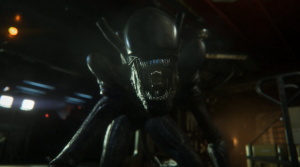Due to being overwhelmed with projects and work, I didn’t get a chance to talk about horror for Halloween. However, I still want to discuss the challenges of horror design. Despite the number of games from the Indie space, good horror design in video games is quite difficult to pull off, and makes for an interesting discussion.
(Anti) Power Fantasy:
Video games by their design are built on fantasy. The two extremes are the power fantasy of action games, and being defenseless in a situation. Every horror game of the last seven years understands the point of being powerless, but that’s not what good horror design is about.
The line between “Bad-ass action hero” and “scared baby” is very wide. There are developers who feel that the second you give the player a weapon that it turns the game into an action title. What they’re forgetting is that “Fight or Flight” is a major part of the human condition. No one is expecting to play a master assassin in a horror game, but we can all relate to swinging a knife in a futile attempt to defend ourselves.
One of the most suspenseful scenes in a horror movie is when the hero has the means of dealing with the killer/monster, and has to attempt to fight them. While our heroes are armed, no one can say that the scene was a power fantasy.
There is a huge difference between Ash going into the cellar in Evil Dead 2 with a shotgun and chainsaw vs. the Doom Guy picking up and cocking his shotgun in Doom 2016.
Without any option to defend, the horror becomes akin to a haunted house rather than a scary experience.
Tension Control:
An important part of good horror design is properly managing the tension throughout the game. There must be a period of building up tension followed by releasing it to keep the audience on edge. This is one of the hardest parts to do right in a video game, because it’s counter intuitive to game design.
We see developers go to either extreme when it comes to tension. Many indie developers focus on nothing but the build up, but then lack an effective way of releasing tension. You can see this in games that only have fixed jump scares or limited interactions. What happens is that without releasing the tension, the player eventually becomes conditioned to treat the game as a series of fixed encounters and the illusion is lost.
On the other extreme, we have developers who do nothing but assaulting the player with enemies or scary events. This is popular in the action-horror genre that frequently makes use of arena fights. The issue here is that without enough time to build up the tension, the player becomes desensitized to the enemies and horror. In a way, this is another reason why Doom 2016 was not at all considered a horror game.
We have seen some horror games go with the idea of a two-tiered enemy system, with one enemy type being your regular foes, while the other stalks the player and cannot be killed.
In both Resident Evil 7 and Alien Isolation, the player has to deal with common enemies and those that you can only avoid.
Due to the Xenomorph “tracking” the player in Isolation, that was a better example of this. When the player doesn’t know where or when the threat is coming from, it helps to raise the tension up. I’m surprised that we haven’t seen more attempts at procedurally generated encounters in horror games.
Another big issue comparing video games to other mediums is the length of the experience. For a two hour movie, the director knows exactly how long the experience is and can properly manage the tension for the entire time. It’s a lot harder to do in a video game with varying times based on the player.
There is more we can talk about regarding enemy and level designs, but I feel that could be its own post.
Belated Boo:
Horror design went from being the hot new genre in the ’90s, deemed a disaster in the ’00s, and has once again achieved popularity this decade. And yet we are rarely seeing developers attempt something new, in favor of repeating the designs of games like Five Nights at Freddy’s or Amnesia.
For you, can you think of horror games not mentioned that took the genre in a different direction?




